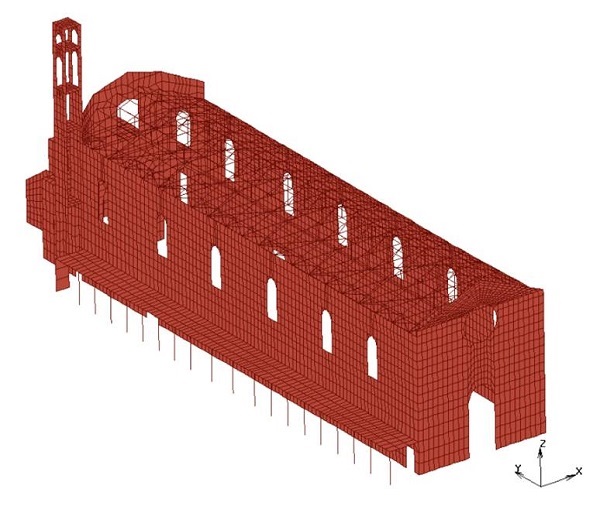by Maria Girardi, Cristina Padovani and Daniele Pellegrini
In Italy many historically and artistically important masonry buildings are in dire need of maintenance and restoration. In order to optimize such operations in terms of cost-effectiveness, architectural impact and static effectiveness, numerical codes have a crucial role to play in modelling the structural behaviour of masonry buildings. By providing important information such as the collapse loads, the stress field and the distribution of cracked regions, together with their possible evolution, such codes represent a valuable support in the choice and design of strengthening and seismic retrofitting operations.
For these reasons, it is crucial to realistically model masonry materials, whose response to tension is fundamentally different from that to compression.
Over recent decades, constitutive models and calculation techniques have become available that enable realistic description of the static and dynamic behaviour of masonry structures. Several studies [1] have led to a better understanding of the constitutive equation of materials not withstanding tension, known in the literature as masonry-like or no-tension materials. Within this framework, masonry is modelled as a nonlinear elastic material, with zero tensile strength and bounded compressive strength. This constitutive model has been implemented into NOSA (NOn-Linear Structural Analysis), a finite element code developed by the Mechanics of Materials and Structures Laboratory of the ISTI-CNR. The development of NOSA began in 1980 with the aim of testing new constitutive models for materials, as well as checking numerical techniques for solving structural engineering problems and has continued over the ensuing years along the research lines of the Lab.
NOSA enables determination of the stress state and the presence of any cracking in masonry structures. It can moreover be applied to modelling needed restoration and reinforcement operations on constructions of particular architectural interest. The code also provides for thermo-mechanical analysis of no-tension solids whose mechanical characteristics depend on temperature in the presence of thermal loads [1]. It has been successfully applied to the analysis of arches and vaults, as well as to a number of studies, commissioned by both private and public bodies, on important historic buildings, such as the chimney of the Vecchi Macelli, the Medici Arsenal and the San Pietro in Vinculis Church in Pisa, the San Nicolò Motherhouse in Noto, the Goldoni Theatre in Livorno, the Baptistery of the Volterra Cathedral, the bell tower of Buti, the church of Santa Maria Maddalena in Morano Calabro, the church of San Ponziano in Lucca, the church of Santa Maria della Roccella in Roccelletta di Borgia and the Rognosa tower in San Gimignano.
In many cases, such studies have also provided important information on the structure's seismic vulnerability, which can be assessed with respect to current Italian and European regulations. Moreover, the effects of thermal variations and the effectiveness of various strengthening interventions can be evaluated, and those with the least environmental and visual impact identified.
With the aim of improving the performance of the NOSA code and equipping it with an interactive graphic tool for pre- and post-processing, the project "Tools for the modelling and assessment of the structural behaviour of ancient constructions: the NOSA-ITACA code" was conducted by the laboratory of Mechanics of Materials and Structures of ISTI-CNR and a research team from the Department of Civil and Environmental Engineering of the University of Florence. The project [2], funded by the Region of Tuscany (2011-2013), was aimed at developing the NOSA-ITACA code, resulting from integration of the NOSA code and the open source graphic platform SALOME [3].
Within the framework of the project, the NOSA code has been substantially modified and deeply improved, in the light of the Fortran 90 specifications, and equipped with new finite elements, thus enhancing its application capabilities. The implementation of the NOSA-ITACA code for the structural analysis of historical masonry constructions has been then completed, by integrating the finite element code NOSA with the open source graphic interactive code SALOME, used both to define the geometry of the structure under examination and to visualise the results of the structural analysis (Figure 1).
NOSA-ITACA has been used for studying the "Voltone", a large vaulted masonry structure located under Piazza della Repubblica in Livorno [4], the church of San Francesco in Lucca [5] (Figure 2), the dome of the San Cerbone cathedral in Massa Marittima [6] and the Maddalena bridge in Borgo a Mozzano (LU) [7] (Figure 3).
NOSA-ITACA is freely distributed with the aim of disseminating the use of mathematical models and numerical tools in the field of Cultural Heritage.
[1] Lucchesi M., Padovani C., Pasquinelli G., Zani N., "Masonry constructions: mechanical models and numerical applications", Series: Lecture Notes in Applied and Computational Mechanics, Vol. 39, Berlin Heidelberg, Springer-Verlag, 2008.
[2] www.nosaitaca.it
[3] www.salome-platform.org
[4] Girardi M., Padovani C., Pellegrini D., "The NOSA-ITACA code for the safety assessment of ancient constructions: a case study in Livorno". Advances in Engineering Software, Elsevier, [Online First 21 April 2015].
[5] Girardi M., Padovani C., Pasquinelli G., "Numerical modelling of the static and seismic behaviour of historical buildings: the church of San Francesco in Lucca", CC2013 Fourteenth International Conference on Civil, Structural and Environmental Engineering Computing (Cagliari, Italy, 3-6 September 2013). Proceedings, article n. 80. B.H.V. Topping, P. Iványi (eds.). Civil-Comp Press, 2013.
[6] Angelini G., De Falco A., Pellegrini D., "Structural Analysis of the dome of San Cerbone Cathedral in Massa Marittima". Proceeding of SACH2014 - International Conference on Structural Analysis of Historical Constructions F. Peña & M. Chávez (eds.) Mexico City, Mexico, 14-17 October 2014.
[7] De Falco A., Girardi M., Pellegrini D., "Nonlinear analyses of the medieval Ponte del Diavolo, Borgo a Mozzano, Italy". CST2014 - Twelfth International Conference on Computational Structures Technology (Naples, iTALY, 2-5 September 2014). Proceedings, vol. CCP 106 article n. 74. B.H.V. Topping, P. Iványi (eds.). Civil-Comp Press, 2014.
Please contact:
Maria Girardi, ISTI-CNR
E-mail: maria.girardi@isti.cnr.it
http://www.isti.cnr.it/research/unit.php?unit=MMS
Cristina Padovani, ISTI-CNR
E-mail: cristina.padovani@isti.cnr.it
http://www.isti.cnr.it/research/unit.php?unit=MMS
Immagini:


